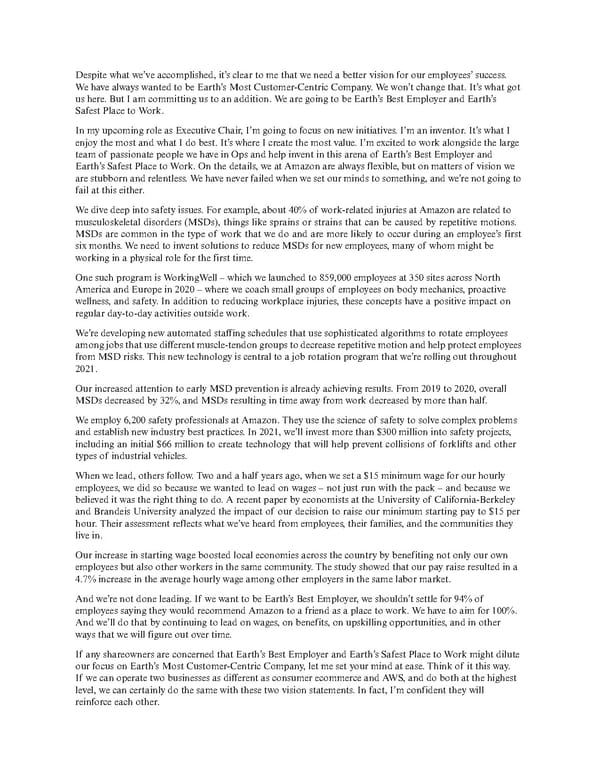Despite what we’ve accomplished, it’s clear to me that we need a better vision for our employees’success. WehavealwayswantedtobeEarth’sMostCustomer-CentricCompany.Wewon’tchangethat.It’swhatgot us here. But I am committing us to an addition. We are going to be Earth’s Best Employer and Earth’s Safest Place to Work. In my upcoming role as Executive Chair, I’m going to focus on new initiatives. I’m an inventor. It’s what I enjoy the most and what I do best. It’s where I create the most value. I’m excited to work alongside the large teamof passionate people we have in Ops and help invent in this arena of Earth’s Best Employer and Earth’s Safest Place to Work. On the details, we at Amazon are always flexible, but on matters of vision we are stubborn and relentless. We have never failed when we set our minds to something, and we’re not going to fail at this either. Wedivedeepintosafetyissues. For example, about 40% of work-related injuries at Amazon are related to musculoskeletal disorders (MSDs), things like sprains or strains that can be caused by repetitive motions. MSDsarecommoninthetypeof work that we do and are more likely to occur during an employee’s first six months. We need to invent solutions to reduce MSDs for new employees, many of whom might be working in a physical role for the first time. OnesuchprogramisWorkingWell – whichwelaunchedto859,000employeesat350sitesacrossNorth AmericaandEuropein2020–wherewecoachsmallgroupsof employeesonbodymechanics,proactive wellness, and safety. In addition to reducing workplace injuries, these concepts have a positive impact on regular day-to-day activities outside work. We’re developing new automated staffing schedules that use sophisticated algorithms to rotate employees amongjobsthatusedifferentmuscle-tendongroupstodecreaserepetitivemotionandhelpprotectemployees fromMSDrisks.Thisnewtechnologyiscentraltoajobrotationprogramthatwe’rerollingoutthroughout 2021. Ourincreased attention to early MSD prevention is already achieving results. From 2019 to 2020, overall MSDsdecreasedby32%,andMSDsresultingintimeawayfromworkdecreasedbymorethanhalf. Weemploy6,200safetyprofessionals at Amazon. They use the science of safety to solve complex problems andestablish new industry best practices. In 2021, we’ll invest more than $300 million into safety projects, including an initial $66 million to create technology that will help prevent collisions of forklifts and other types of industrial vehicles. Whenwelead,othersfollow.Twoandahalf yearsago,whenweseta$15minimumwageforourhourly employees, we did so because we wanted to lead on wages – not just run with the pack – and because we believed it was the right thing to do. A recent paper by economists at the University of California-Berkeley and Brandeis University analyzed the impact of our decision to raise our minimum starting pay to $15 per hour. Their assessment reflects what we’ve heard from employees, their families, and the communities they live in. Ourincrease in starting wage boosted local economies across the country by benefiting not only our own employees but also other workers in the same community. The study showed that our pay raise resulted in a 4.7%increase in the average hourly wage among other employers in the same labor market. Andwe’renotdoneleading.If wewanttobeEarth’sBestEmployer,weshouldn’tsettlefor94%of employees saying they would recommend Amazon to a friend as a place to work. We have to aim for 100%. Andwe’lldothatbycontinuingtoleadonwages,onbenefits,onupskillingopportunities, and in other waysthat we will figure out over time. If any shareowners are concerned that Earth’s Best Employer and Earth’s Safest Place to Work might dilute our focus on Earth’s Most Customer-Centric Company, let me set your mind at ease. Think of it this way. If we can operate two businesses as different as consumer ecommerce and AWS, and do both at the highest level, we can certainly do the same with these two vision statements. In fact, I’m confident they will reinforce each other.
 Amazon Shareholder Letters 1997-2020 Page 108 Page 110
Amazon Shareholder Letters 1997-2020 Page 108 Page 110